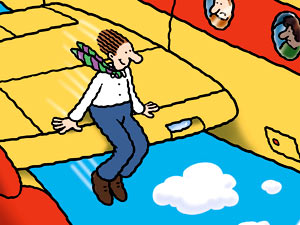 |
| Mobile telephony aloft is fun but that is just the first step. |
COMMUNICATION is easy. Social bonhomie and the need to talk is built into our DNA. Ask any teenager or working suit under 25 and they'll show you how it's done. They get all their friends together in one room, slump in various corners, and furiously text each other on cell phones. This may sound alarming for parents who have no idea how to retrieve messages let alone send a text message. I do things the primitive way. I talk. Remember that?
Fortunately, some kids are different. Perhaps it's the parenting. They walk briskly into a room, grin sheepishly, make some eye contact, and then slump in various corners tapping on their laptops to chat with each other on Facebook. Now, 30,000ft aloft your groovy boss is going to play the same game and deny you 16 precious hours of sleep on the Hong Kong-New York flight. Why? Because he can.
Send us your Feedback / Letter to the Editor  Share This Page Share This Page
In the first half of 2011, Singapore Airlines, teaming up with inflight connectivity alchemist OnAir, will start streaming in WiFi Internet with e-mail and texting facilities for smartphones and the BlackBerry (but not voice telephony initially). The service will phase in on 43 aircraft – the A380 behemoth, A340-500s and the B777-300ERs. Travellers will pay their own service providers for international roaming while SIA will levy a charge for Internet use. This is nothing short of revolutionary. It eliminates all information blackouts and downtime. I will now be able to link in from wherever I am, with my son and several slumped young men in my home, and thus fall instantly asleep. Who needs melatonin?
By 2012, Cathay Pacific and Dragonair expect to introduce a "Panasonic Avionics Global Communications Suite" that will provide Broadband connectivity to all aboard. Talk, text, play games or knock out your teeth with a hot iron as an alternative to chatting with your eager office accountant. All this through a Cathay portal. Passengers could ring up a few dollars on live TV too.
And darting through the electronic static is low cost gadfly AirAsia, which hopes to be the first in the ring, albeit with a limited footprint. It has teamed up with Malaysia-based Maxis and OnAir to trial full service smartphone access on a few aircraft for Maxis subscribers who will be able to e-mail, text, and access the Internet (through GPRS) at their normal roaming rates. This facility is a serious blow on the chin at around US$3.50 per minute.
In the first half of 2011, SIA will start rolling out WiFi Internet and text, aloft. Travellers will pay their service providers for roaming and the airline will charge a usage fee
The idea of connectivity while flying is not novel and has probably been around since Charles Lindbergh discovered on 20 May, 1927 that he had taken off for Paris with just four sandwiches. Connexion by Boeing pioneered the onboard concept in 2005 but the initiative – trialled by Singapore Airlines, Cathay Pacific, Lufthansa, Korean Air and others – petered out within a year.
Today as many as 1,028 aircraft in the US have been kitted out with Wireless hotspots to relay signals from a company called Gogo. Gogo (an Aircell company) uses cellular towers on the ground to transmit data to aircraft antennae while in flight. This system does not interfere with aircraft navigation as the pilots and their inflatable dolls in the cockpit are usually otherwise distracted. Gogo starts its pricing at US$19.95 for the first month with a 30-day pass on "any Gogo equipped airline" at US$39.95. The catch is the flight must traverse contiguous US territory in order to pick up an unbroken feed. Goodbye Hawaii. Cell phones and laptops can all plug in but voice service, while eminently possible, is not permitted in the cabin. The luxury of connecting starts above 10,000ft, a safe elevation, according to the FAA. Travellers can explore this option with carriers like American Airlines, United, Virgin America, Delta, and Alaska Airlines.
While Asian airlines offer everything onboard but the Colosseum and plump Christians being fed to lions in an effort to woo passengers increasingly afflicted by attention deficit hyperactivity disorder, American carriers are intrigued by the potential of this sort of WiFi feed. It offers an opportunity to stream in entertainment on demand via service providers, while at the same time saving cost, weight and electrical hassles with seat-back video screens.
But, as everywhere today, getting passengers to pay is like pulling teeth. Alaska Airlines floated a modest US$1 levy and watched despairingly as usage plummeted. Willingness to pay is directly linked to the duration of the flight. It should not be too difficult to get well-heeled punters flying HK-NY longhaul or Singapore-LAX to cough up. Singapore-KL is another matter.
Other OnAir partner airlines include British Airways, Egypt Air, and Qatar Airways. While we wait for SIA's soft-focus Singapore Girls, online, and screaming 50Mbps Internet on Cathay, I wonder whether a new age is about to dawn? Now 300 passengers on the flight can board, grin, and then slump in their seats texting each other. Make eye contact somebody. It's not too hard.
Send us your Feedback / Letter to the Editor |